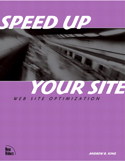Flow in Web Design--Chapter 2 from Speed Up Your Site (1/5) WebReference.com
[next] |
Speed Up Your Site:
Web Site Optimization

Chapter 2: Flow in Web Design
[The following book excerpt is chapter 2 of the New Riders title, Speed Up Your Site: Web Site Optimization.]
Imagine that you're doing your favorite activitylet's say, sailing. You're skimming along the waves, when suddenly the breeze freshens. You hike out to compensate, leaning back into the wind to keep the boat upright. A wave splashes your face. You shake your head and trim the main sheet for more speed. You are entirely focused on the movements of your body, the water rushing past, and keeping the boat right side up.
You're really flying now, just on the edge of control. You're so fully immersed in this activity, there's no room left in your awareness for distractions. Otherwise, you might catch a wave and capsize. You're having so much fun that you want this moment to last forever. Mihaly Csikszentmihalyi calls these exceptional moments flow experiences.[1] Flow can occur in practically any activity, including browsing the web.
This "optimal experience"[2] is "intrinsically enjoyable."[3] Time seems to stand still, and we lose our sense of self. We feel playful and are willing to try (and presumably buy) new things. Although flow can occur anywhere, certain activities like rock climbing, performing surgery, chess, and sailing lend themselves to this optimal state of focused attention. Responsive, well-designed web sites can also induce flow in their users.
On Flow and Mihaly Csikszentmihalyi
Mihaly Csikszentmihalyi, a professor and former chair of the Department of Psychology at the University of Chicago, pioneered the study of flow. He wrote that flow is the "holistic sensation that people feel when they act with total involvement."[4]
Csikszentmihalyi wanted to understand the experience of enjoyment. He asked, what motivates people to perform better? Extrinsic rewards like money and prestige are limited resources that ultimately are about comparisons between people. Status is a zero-sum game; so something else must motivate us humans. Intrinsic rewards, doing activities for the sheer joy of it, are the key to understanding flow.[5]
In order to understand intrinsic motivation, Csikszentmihalyi studied self-rewarding, or autotelic, activities. Csikszentmihalyi knew that if he could understand what made us tick, he could revolutionize how we work and play. He observed painters, rock climbers, dancers, musicians, and surgeons, taking surveys and later paging them at random intervals. His goal was to answer one of life's greatest questions: What makes life worth living?
[next] |
1. Mihaly Csikszentmihalyi, Finding Flow: The Psychology of Engagement with Everyday Life (New York: Basic Books, 1997), 29. Back
2. Mihaly Csikszentmihalyi, Optimal Experience (New York: Cambridge University Press, 1988). Back
3. Gayle Privette and Charles M. Bundrick, "Measurement of Experience: Construct and Content Validity of the Experience Questionnaire," Perceptual and Motor Skills 65 (1987): 315332. Back
4. Mihaly Csikszentmihalyi, Beyond Boredom and Anxiety: Experiencing Flow in Work and Play (1975; reprint, with a Preface by Mihaly Csikszentmihalyi, San Francisco: Jossey-Bass, 2000), 36. Back
Created: February 5, 2003
Revised: February 23, 2003
URL: https://webreference.com/programming/optimize/speedup/chap2/


 Find a programming school near you
Find a programming school near you